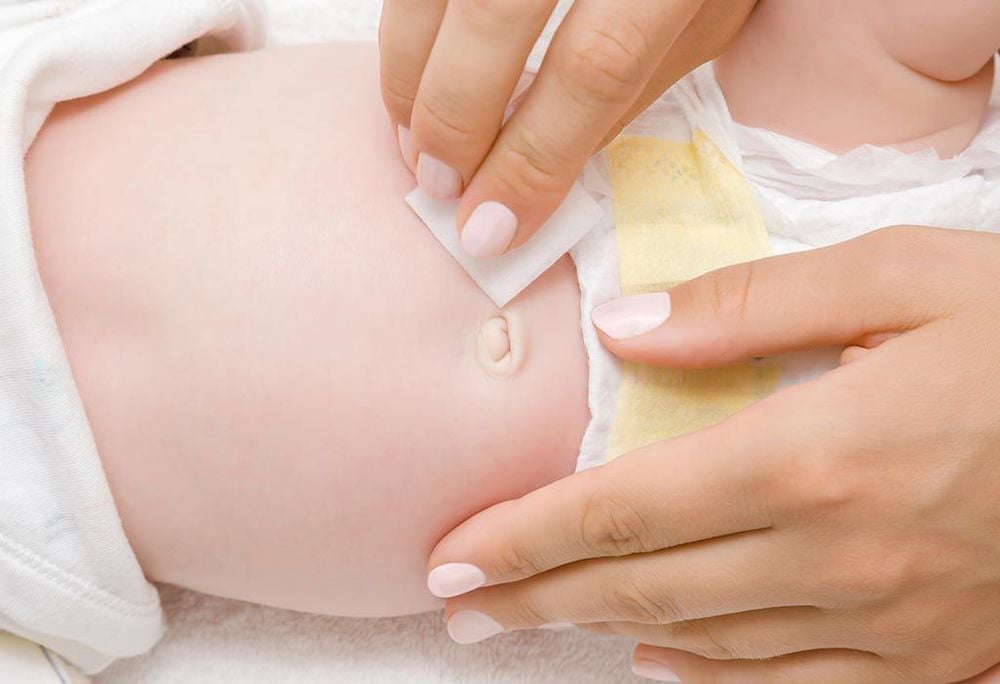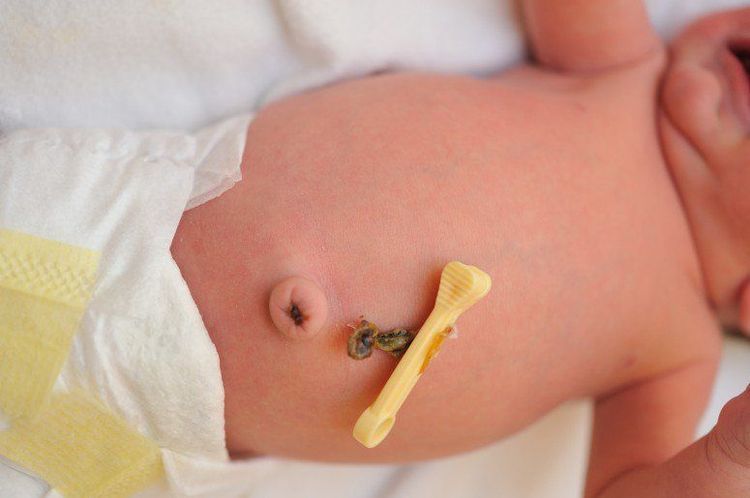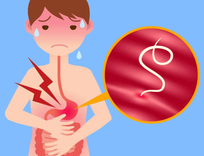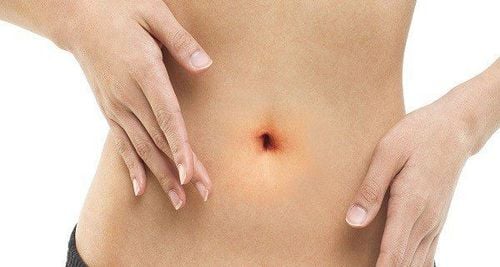After the umbilical cord falls off, parents should keep the area clean and dry to prevent infection. This includes avoiding prolonged water exposure, not applying powders or medications, and ensuring that the area remains hygienic to reduce the risk of umbilical infections, which can affect the baby's health.
1. What should be done after an infant’s umbilical cord falls off?
The umbilical cord typically falls off 8–10 days after birth. During this period, the area is very sensitive and prone to infection if not cared for correctly. Therefore, knowing the necessary steps for care is crucial for parents.
Here are some recommended practices:
- Umbilical hygiene process: Wash your hands thoroughly. Soak a cotton swab in 70% alcohol or 0.9% saline solution and gently clean the umbilical stump and the surrounding area within a 5 cm radius. Clean by rolling outward from the center and change cotton swabs regularly until the area is clean.
- Keep the umbilical stump dry and clean: Let the stump air dry naturally to help it fall off faster. Avoid covering it with bandages, as this can trap moisture and increase infection risk.
- Bathing precautions: The baby can be bathed in a basin to clean the umbilical area, but avoid soaking for extended periods. After bathing, pat the baby dry gently with a soft towel, ensuring the stump stays dry.
- Clothing considerations: Choose loose-fitting, breathable clothing to avoid irritation or friction at the umbilical area, which could increase infection risks.
- Diapering: Prepare all necessary items before changing diapers. Clean the area gently with a soft cloth or cotton swab, and dry it thoroughly. Ensure the diaper is folded down below the umbilical area or fastened loosely to avoid contact with the stump or urine.
Allowing the umbilical area to dry naturally is one of the essential steps in aftercare.

2. When does the umbilical cord fall off?
The average time for an umbilical cord to fall off is between 8–10 days, though in some cases, it may take up to 2 weeks. During this time, ensure the area is kept clean and dry. Avoid prolonged water exposure, and do not apply ointments, creams, or powders to the umbilical area.
3. Common umbilical issues after birth
Poor umbilical care can cause complications, slowing the healing process and affecting the baby’s health. Common issues include:
- Umbilical bleeding: Bleeding often occurs at the base of the stump or the umbilical attachment point. It typically stops on its own or with light pressure using a sterile gauze. If bleeding persists beyond 3 instances or lasts over 1 minute, consult a doctor immediately.
- Delayed umbilical cord separation: While the average separation time is 8–10 days, some cases may take 2–3 weeks. Continue cleaning any discharge gently, avoid diaper contact with the stump, and monitor the surrounding skin daily. If separation hasn’t occurred after 3 weeks, seek medical advice.
- Umbilical discharge or pus: This is a sign of infection and requires immediate medical consultation. Keep the area clean and avoid applying antibiotics or antiseptics without medical supervision.
- Umbilical infection: Symptoms include redness, swelling, tenderness, and pus discharge from the surrounding area. Severe cases may require hospital care and appropriate antibiotic treatment.
- Umbilical granuloma: This condition involves a reddish mass at the base of the stump after it falls off, which can lead to prolonged discharge and inflammation. Medical treatment, such as topical application, oral medication, or cauterization, may be necessary.
- Umbilical tetanus: Caused by tetanus bacteria entering through the umbilical stump, symptoms include refusal to feed, fever, jaw stiffness, and full-body rigidity, which can be life-threatening.
- Umbilical hernia: This occurs in 10–20% of newborns when a weakness in the abdominal muscles under the umbilical area allows bowel loops to protrude, creating a bulge. It’s usually painless and resolves by age 4. Surgical intervention may be needed if the bulge exceeds 2.5 cm or persists after 4 years. In rare cases, strangulated hernias causing pain and vomiting require immediate medical attention.

4. How to care for an infected umbilical cord?
The following steps should be taken if the umbilical cord shows signs of infection:
- Wash hands before and after cleaning the area.
- Ensure diapers sit below the umbilical area to avoid contamination with stool or urine.
- Avoid tight clothing around the umbilical stump.
- Refrain from using baby powders or any powdered substances on the infected area.
- Monitor for severe infection signs like high fever, foul-smelling discharge, significant swelling or redness around the umbilical area, prolonged crying, refusal to feed, or lethargy. If any of these occur, seek immediate medical attention.
In summary, the umbilical cord typically separates within 8–10 days. After separation, the area still requires diligent care to ensure it remains clean and dry. Any signs of unusual bleeding, discharge, or infection should prompt a visit to a healthcare provider for timely intervention.
To schedule an appointment at the hospital, please contact the HOTLINE or book directly HERE. Download the MyVinmec App to manage, track, and schedule appointments conveniently anytime, anywhere.













